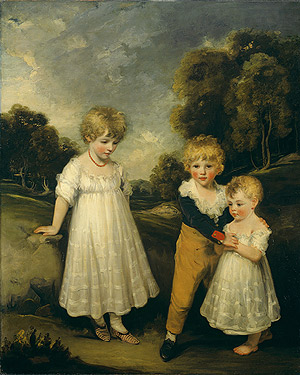Children's Fashion
When a child was born, the infant was wrapped in swaddling bands for the first six to twelve months. This was done because it was considered unhealthy for an infant to have free use of their arms and legs. As the child grows older, boys and girls alike, would be put into dresses and skirts. Boys would wear dresses until the ages three through seven. After the boys reached this age range, they would begin to wear breeches. This ceremony was known as breeching and would be celebrated with a big party (Secara).

This is a painting of the children of the third duke of Dorset. This picture was painted at the royal academy in 1797. The two young girls are wearing thin, white gowns. The young boy is wearing a collared shirt with beige pants and black shoes. This means that the boy must be in between the ages of three and seven, because he has already had his breaching ceremony. The tallest girl is wearing light brown shoes and a red beaded necklace. The youngest girl is not wearing any shoes or jewelry, most likely because of her young age.
Hoppner, John. The Sackville Children. 1796. The Metropolitan Museum of Art, New
York. Heilbrunn Timeline of Art History. Web. 2 Apr. 2013.
